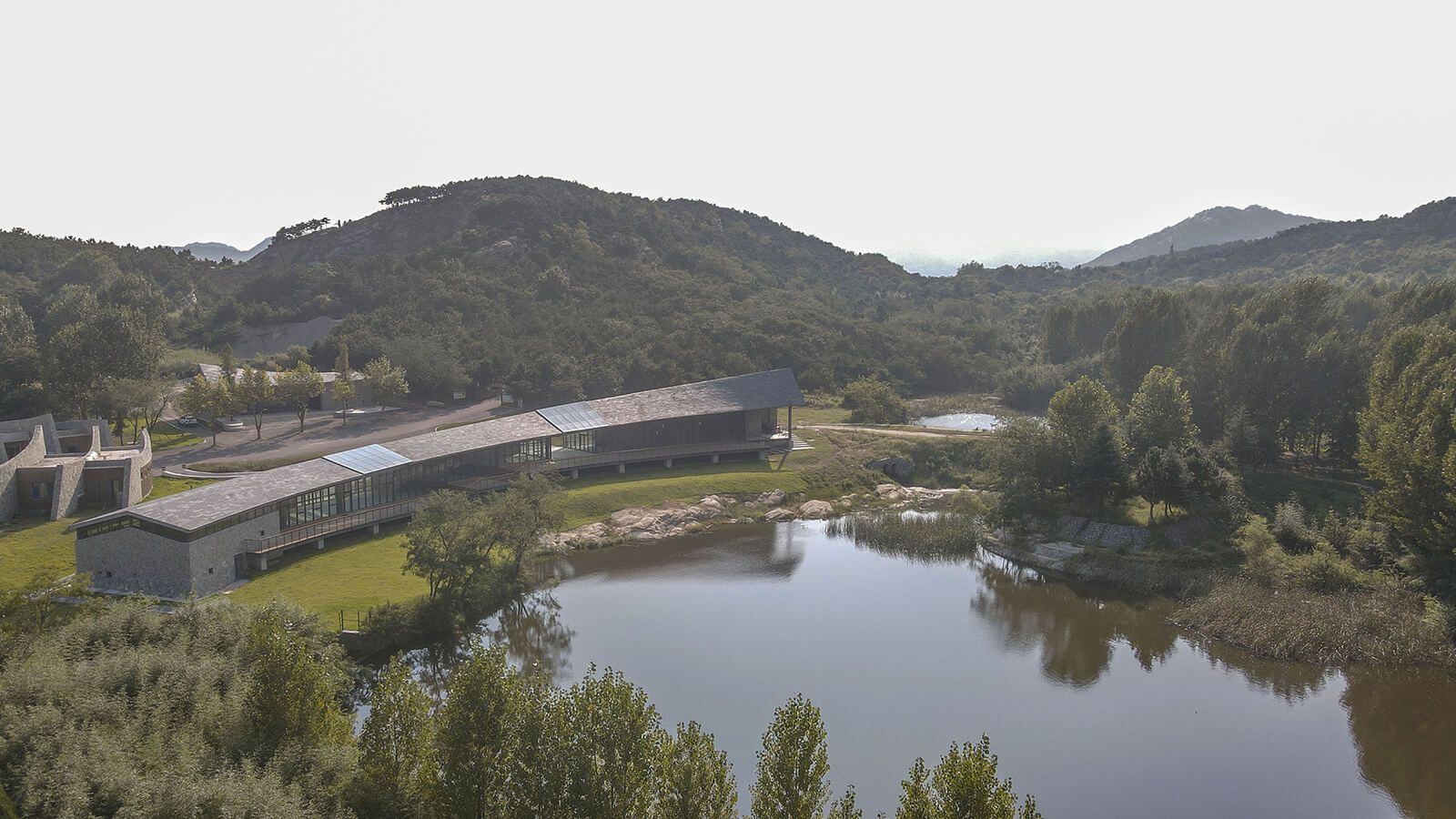The art of casting sculptural architecture from liquid stone: concrete
by Jincy IypeDec 17, 2022
•make your fridays matter with a well-read weekend
by Aatmi ChitaliaPublished on : Mar 25, 2024
The Dragon Mountain Tourist Center has been designed by French architect Aurélien Chen as an articulation of the threshold between the land and the sky, amidst a verdant mountainous terrain in Rizhao City of China. This public space subtly connects visitors to its beautiful surroundings—limpid streams, quiet valleys and lush forests—with a built environment that curves along the ebb and flow of the natural terrain. Chen surgically uses elements from vernacular Chinese architecture for this design and sculpts a sinuous form in harmony with the site, reaching towards the Dragon Mountain.

A spiritual experience of connection begins immediately upon entering the site as the visitor is welcomed by a glimpse of the mountain along the entrance alley. The entrance gate reveals a series of slanted fortifications, merging into the architectural ensemble. This gateway is a combination of three rows of angular walls that define the public square outside and house a ticket counter and a security station on either of its ends. Rather than a constructed portal, which could have been the conventional approach, the entry point is an unconstructed void between the walls. This path frames the distant mountain peaks while marking the arrival of the incoming visitors, inviting them to embark on a journey of exploration and discovery. Upon entering, the onward path diverges into two lanes; one ascending towards the mountain and the other descending towards tranquil ponds lined with trees.
The spatial arrangement of the complex mimics the planning and fortifications of ancient Chinese architecture, especially of cities and palaces in terms of the progression of spaces. The sequential organisation of walls guides visitors towards each structure within the complex while maintaining a sense of intrigue and anticipation toward the larger space, design, and context. The ascending form of the buildings is inspired by the Chinese belief in the verticality of the cosmic triad—the Earth, the human and the heavens.
Since the priority was to frame the existing natural features through the built composition, the architectural intervention called for fragmenting the required 3000 sqm programme area into five distinct masses adapted to the landscape. Evolved for the intended dialogue between architecture and nature, the architectural masses exhibit a slender and subtle design, laid out around a central square. Their heights vary symphonically, with the lower sides of each mass firmly grounded in the sloping topography, facing the entrance, symbolising a connection to the Earth, while the sides facing the mountains are higher with an ascending roof that appears to reach towards the heavens. With humans being the witnesses in this structure nestled between the earth and the sky, the composition completes the cosmic triad, reinforcing the overarching connection.
The centre honours Chinese vernacular architecture not only in terms of its layout but also in terms of the approach to materials and building technique. The use of locally sourced materials, such as stone cladding and bamboo, emphasises the integration of the complex with its surroundings. Further, exposed concrete, cast with the help of wooden formwork, represents the irregularity and texture of natural elements. Natural bamboo screens feature as fenestrations, to add a layer of delicacy amidst the looming solidity. Elsewhere, transparent glass has been used as the primary material for the facade, to blur the boundaries between interior and exterior spaces.
Chen’s design outcome is seamless and nuanced because of his familiarity and research of the site, which helped the realisation of a former project, The Dragon Mountain Pavilion in 2019. The complex invites the tourists to immerse themselves in a world where the boundaries between the earth and the sky, architecture and landscape become indefinite and buoy up the spirits of the tourists with assurance and adventure.
Name: Dragon Mountain Tourist Center
Location: Rizhao, China
Client: Rizhao Fada Jituan
Area:
Designed area: 2400 sqm
Built area: 1700 sqm
Architect: Aurelien Chen (project & design lead) + Urban and rural planning and design institute of CSCEC
Partners in charge: Aurelien Chen and Wu Yixia (Urban and rural planning and design institute of CSCEC)
Design team: Aurelien Chen, Ma Jing, Wang Manyu
Technical collaborator: Lifeng Architecture Studio
Completion: 2023
by Bansari Paghdar Oct 16, 2025
For its sophomore year, the awards announced winners across 28 categories that forward a contextually and culturally diverse architectural ecosystem.
by Mrinmayee Bhoot Oct 14, 2025
The inaugural edition of the festival in Denmark, curated by Josephine Michau, CEO, CAFx, seeks to explore how the discipline can move away from incessantly extractivist practices.
by Mrinmayee Bhoot Oct 10, 2025
Earmarking the Biennale's culmination, STIR speaks to the team behind this year’s British Pavilion, notably a collaboration with Kenya, seeking to probe contentious colonial legacies.
by Sunena V Maju Oct 09, 2025
Under the artistic direction of Florencia Rodriguez, the sixth edition of the biennial reexamines the role of architecture in turbulent times, as both medium and metaphor.
 surprise me!
surprise me!
make your fridays matter
SUBSCRIBEEnter your details to sign in
Don’t have an account?
Sign upOr you can sign in with
a single account for all
STIR platforms
All your bookmarks will be available across all your devices.
Stay STIRred
Already have an account?
Sign inOr you can sign up with
Tap on things that interests you.
Select the Conversation Category you would like to watch
Please enter your details and click submit.
Enter the 6-digit code sent at
Verification link sent to check your inbox or spam folder to complete sign up process



by Aatmi Chitalia | Published on : Mar 25, 2024
What do you think?